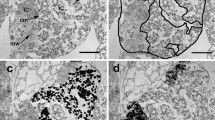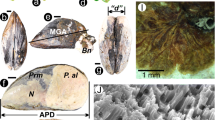Abstract
Methane mussels (Bathymodiolus sp., undescribed; personal communication by R. Turner to CRF) were collected in September 1989 and April 1990 from offshore Louisiana in the Gulf of Mexico. These mussels contain endosymbiotic methane-oxidizing bacteria and are capable of utilizing environmental methane as a source of energy and carbon. Oxygen consumption, methane consumption, and carbon dioxide production were measured in mussels with intact symbionts, functionally aposymbiotic mussels, and separated symbiont preparations under controlled oxygen and methane conditions, in order to study the roles of the symbionts and the hosts in methane utilization. The association was found to be very efficient in fixing methane carbon (only ∼30% of CH4 consumed is released as CO2), and to be capable of maximal rates of net carbon uptake of nearly 5 μmol g-1 h-1. Rates of oxygen and methane consumption were dependent upon oxygen and methane concentrations. Maximal consumption rates were measured at 250 to 300 μM O2 and 200 to 300 μM CH4, under which conditions, oxygen consumption by the gill tissues (containing symbionts) had increased more than 50-fold over rates measured in the absence of methane. A model is proposed for the functioning of the intact association in situ, which shows the symbiosis to be capable of achieving growth rates (net carbon assimilation) in the range of 0.003 to 0.50% per day depending upon oxygen and methane concentrations. Under the conditions measured in the seep environment (200 μM O2, 60 μM CH4), a mussel consuming methane at rates found to be typical (4 to 5 μmol g-1 h-1) should have a net carbon assimilation rate of about 0.1% per day. We suggest that the effectiveness of this symbiosis arises through integration of the morphological and physiological characteristics inherent to each of the symbiotic partners, rather than from extensive specialization exhibited by other deep-sea chemotrophic associations.
Similar content being viewed by others
Literature cited
Anderson, A. E., Childress, J. J., Favuzzi, J. (1987). Net uptake of CO2 driven by sulfide and thiosulfate oxidation in the bacterial symbiont-containing clam Solemya reidi. J. exp. Biol. 133:1–31
Anthony, C. (1982). The biochemistry of methylotrophs. Academic Press, London
Arp, A. J., Childress, J. J. (1981). Blood function in the hydrothermal vent vestimentiferan tube worm. Science, N.Y. 213: 342–344
Arp, A. J., Childress, J. J. (1983). Sulfide binding by the blood of the hydrothermal vent tube worm Riftia pachyptila. Science, N.Y. 219: 295–297
Arp, A. J., Childress, J. J., Fisher, C. R., Jr. (1984). Metabolic and blood gas transport characteristics of the hydrothermal vent bivalve, Calyptogena magnifica. Physiol. Zoöl. 57: 648–662
Arp, A. J., Childress, J. J., Fisher, C. R., Jr. (1985). Blood gas transport in Riftia pachyptila. Bull. biol. Soc. Wash. 6: 289–300
Bayne, B. L. (1976) Marine mussels, their ecology and physiology. Cambridge University Press, Cambridge
Brooks, J. M., Kennicutt, M. C., II, Fisher, C. R., Macko, S. A., Cole, K., Childress, J. J., Bidigare, R. R., Vetter, R. D. (1987). Deep-sea hydrocarbon seep communities: evidence for energy and nutritional carbon sources. Science, N.Y. 238: 1138–1142
Cary, S. C., Fisher, C. R., Felbeck, H. (1988). Mussel growth supported by methane as sole carbon and energy source. Science, N.Y. 240: 78–80
Cavanaugh, C. M., Gardiner, S. L., Jones, M. L., Jannasch, H. W., Waterbury, J. B. (1981). Prokaryotic cells in the hydrothermal vent tube worm Riftia pachyptila: possible chemoautotrophic symbionts. Science, N.Y. 213: 340–342
Childress, J. J., Arp, A. J., Fisher, C. R., Jr. (1984). Metabolic and blood characeristics of the hydrothermal vent tube-worm Riftia pachyptila. Mar. Biol. 83: 109–124
Childress, J. J., Fisher, C. R., Brooks, J. M., Kennicutt, M. C., II, Bidigare, R., Anderson, A. (1986). A methanotrophic marine molluscan symbiosis: mussels fueled by gas. Science, N.Y. 233: 1306–1308
Childress, J. J., Fisher, C. R., Favuzzi, J. A., Kochevar, R. E., Sanders, N. K., Alayse, A. M. (1991). Sulfide-driven autotrophic balance in the bacterial symbiont-containing hydrothermal vent tubeworm, Riftia pachyptila Jones. Biol. Bull. mar. biol. Lab., Woods Hole 180: 135–153
Distel, D. L., Felbeck, H. (1988). Pathways of inorganic carbon fixation in the endosymbiont bearing lucinid clam Lucinoma aequizonata: Part 2. Analysis of the individual contributions of host and symbiont to inorganic carbon assimilation. J. exp. Zool. 247: 11–22
Felbeck, H., Somero, G. N., Childress, J. J. (1981). Calvin-Benson cycle sulphide oxidation enzymes in animals from sulphide rich habitats. Nature, Lond. 293: 291–293
Fisher, C. R. (1990). Chemoautotrophic and methanotrophic symbioses in marine invertebrates. CRC critical. Rev. aquat. Science 2: 399–436
Fisher, C. R., Childress, J. J., Arp, A. J., Brooks, J. M., Distel, D., Favuzzi, J. A., Felbeck, H., Hessler, R., Johnson, K. S., Kennicutt, M. C., II, Macko, S. A., Newton, A., Powell, M. A., Somero, G. N., Soto, T. (1988). Microhabitat variation in the hydrothermal vent mussel Bathymodiolus thermophilus, at Rose Garden vent on the Galapagos rift. Deep-Sea Res. 35: 1769–1792
Fisher, C. R., Childress, J. J., Oremland, R. S., Bidigare, R. R. (1987) The importance of methane and thiosulfate in the metabolism of the bacterial symbionts of two deep-sea mussels. Mar. Biol. 96: 59–71
Heinzle, E., Furukawa, K., Dunn, I. J., Bourne, J. R. (1983). Experimental methods for on-line mass spectrometry in fermentation technology. Biotechnology 1(2): 181–188
Hobbie, J. E., Daley, R. J., Jasper, S. (1977). Use of Nuclepore filters for counting bacteria by fluorescence microscopy. Appl. envirl Microbiol. 33: 1225–1228
Hughes, D. E., Wimpenny, J. W. T. (1969). Oxygen metabolism by microorganisms. Adv. microb. Physiol 3: 197–232
Joergensen, L, Degn, H. (1983). Mass spectrometric measurements of methane and oxygen utilization by methanotrophic bacteria. Fedn eur. microbiol. Soc. (FEMS) Lett. 20: 331–335
MacDonald, I. R., Boland, G. S., Baker, J. S., Brooks, J. M., Kennicutt, M. C., II, Bidigare, R. R. (1989). Gulf of Mexico hydrocarbon seep communities. II. Spatial distribution of seep organisms and hydrocarbons at Bush Hill. Mar. Biol. 101: 235–247
Mangum, C., Winkle, W. V. (1973). Responses of aquatic invertebrates to declining oxygen conditions. Am. Zool. 13: 529–541
Muller, L. L., Jacks, T. J. (1975). Rapid chemical dehydration of samples for electron microscopic examinations. J. Histochem. Cytochem. 23: 107–110
Page, H. M., Fisher, C. R., Childress, J. J. (1990). Role of filter-feeding in the nutritional biology of a deep-sea mussel with methanotrophic symbionts. Mar. Biol. 104: 251–257
Schmaljohann, R., Flügel, H. J. (1987). Methane-oxidizing bacteria in Pogonophora. Sarsia 72: 91–98
Somero, G. N., Anderson, A. E., Childress, J. J. (1989). Transport, metabolism and detoxification of hydrogen sulfide in animals from sulfide rich marine environments. CRC critical Rev. aquat. Sciences 1: 591–614
Author information
Authors and Affiliations
Additional information
Communicated by M. G. Hadfield, Honolulu
Rights and permissions
About this article
Cite this article
Kochevar, R.E., Childress, J.J., Fisher, C.R. et al. The methane mussel: roles of symbiont and host in the metabolic utilization of methane. Marine Biology 112, 389–401 (1992). https://doi.org/10.1007/BF00356284
Accepted:
Published:
Issue Date:
DOI: https://doi.org/10.1007/BF00356284




